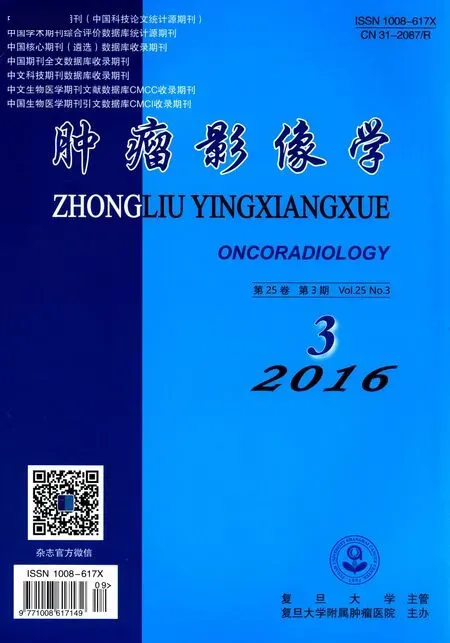以表皮生长因子受体为靶点的脑肿瘤分子显像剂研究进展
张慧玮 综述 管一晖 审校
复旦大学附属华山医院PET中心,上海 200235
以表皮生长因子受体为靶点的脑肿瘤分子显像剂研究进展
张慧玮 综述 管一晖 审校
复旦大学附属华山医院PET中心,上海 200235
表皮生长因子受体(epidermal growth factor receptor,EGFR)属酪氨酸激酶型受体,EGFR基因扩增、重排和突变导致的EGFR蛋白过度表达是原发性胶质母细胞瘤中最常见的遗传变异。目前,常规肿瘤分子病理学手段不能对无法获得标本的胶质瘤患者进行检测,而PET通过影像学手段检测病灶。根据EGFR生物化学特征,靶向EGFR的显像剂可分为核素标记的酪氨酸激酶抑制剂和核素标记的单克隆抗体。
表皮生长因子受体;胶质瘤;酪氨酸激酶抑制剂;单克隆抗体

张慧玮,复旦大学附属华山医院PET中心主治医师,2010年毕业于复旦大学上海医学院临床医学(七年制),现为临床在职博士。2010—2012年完成复旦大学附属华山医院住院医师规范化培训,并在PET中心从事PET相关脑功能研究及脑肿瘤显像研究至今。发表多篇国内核心期刊及SCI收录期刊论著及综述。2016年获得上海市科学技术委员会“上海市青年科技英才扬帆计划”资助。
表皮生长因子受体(epidermal growth factor receptor,EGFR)是一种糖蛋白,属酪氨酸激酶型受体,是ErbB受体家族成员。生长因子结合至其胞外结构域,引起胞内酪氨酸激酶结构域磷酸化,EGFR被激活并启动信号通路[Ras/丝裂原活化蛋白激酶(mitogen-activated protein kinase, MAPK)、磷脂酰肌醇-3激酶(phosphatidylinositol 3-kinase,PI3K)/蛋白激酶B (protein kinase B,Akt)],导致DNA转录增加,从而发挥抗细胞凋亡、血管生成和细胞增殖的作用[1]。EGFR基因位于7号染色体断臂上(7p11.2),编码相对分子质量为170 000的糖蛋白,包括富含半胱氨酸的胞外结构域(外显子1~16)、具有酪氨酸激酶活性的胞内结构域(外显子18~28)和跨膜调节结构域(外显子17)[2]。所有头颈部肿瘤均伴随EGFR过度表达,其次是胰腺癌、肾细胞癌、结肠癌、乳腺癌、卵巢癌、前列腺癌、膀胱癌、非小细胞肺癌和恶性胶质瘤等[3]。EGFR基因扩增、重排和突变导致的EGFR蛋白过度表达是原发性胶质母细胞瘤(glioblastoma,GBM)中最常见的遗传变异,见于约40%的原发性GBM[4-5]。63%~75% EGFR蛋白过度表达的GBM中可发现EGFR基因重排,导致肿瘤中表达野生型EGFR与突变型EGFR[5]。
目前,常规肿瘤分子病理学检测手段需对手术切除的肿瘤标本进行检测。但对于肿瘤位置较深或肿瘤呈弥漫性生长而无法切除的病例,只能依靠穿刺活检。然而,由于肿瘤的异质性,对穿刺活检获取的标本进行分子病理学检测往往不能反映整个肿瘤的分子特征;此外,对于那些因肿瘤位于大血管旁、脑干、基底节区或丘脑深部或自身存在严重系统性疾病而无法耐受切除或穿刺手术的病例,由于无法获得肿瘤标本,无法用常规分子病理学方法检测肿瘤的分子特征。因此,PET等影像学方法特别是近年来出现的分子影像学方法,因其无创、可重复、特异性高且能显示肿瘤整体标记表达情况等优点,成为检测和全面分析肿瘤分子病理学特征、筛选靶向性药物的新途径。虽然同属放射性核素显像,与SPECT相比,PET具有更高的灵敏度、更好的空间分辨率及更精准的体容定量测定。PET/CT成像依赖放射性核素,故根据EGFR的生物化学特征,产生了两类显像剂。
⑴ 核素标记的酪氨酸激酶抑制剂(tyrosine kinase inhibitor,TKI):EGFR小分子抑制剂标记显像主要应用喹唑啉家族衍生物。喹唑啉类能竞争性结合EGFR胞内区的ATP结合位点,部分可作为EGFR靶向治疗药物,已成功用于临床(如吉非替尼、厄洛替尼等)。这种显影剂主要以治疗肿瘤的4-苯胺喹唑啉化合物为基础,用核素标记,通过与EGFR胞内酪氨酸激酶结构域结合显像来提示肿瘤中EGFR表达。但核素标记的TKI显影剂无特异性,无法特异性地与表达指定表型的肿瘤结合,如表皮生长因子受体Ⅲ型突变(epithelial growth factor receptor variant Ⅲ,EGFR vⅢ)[6]。
⑵ 核素标记的单克隆抗体(简称单抗):核素标记的EGFR抗体和EGF显像剂仅能识别并结合EGFR胞外区,不能有效识别EGFR胞内区酪氨酸激酶活性变化,对于由EGFR基因突变所造成的酪氨酸激酶活性增加则无法检测。其摄取与肿瘤表达EGFRvⅢ的含量紧密相关[7],成为很好的检测肿瘤中EGFRvⅢ表达的无创检测方法。但标记EGFR抗体和EGF还可与胞外游离EGFR进行非特异性结合,导致非特异性显像,从而影响结果的特异性。
1 EGFR-TKI显像
最先标记的EGFR-TKI显像剂是11CPD153035[8],主要应用于非小细胞肺癌[9]。在胶质瘤患者中,其放射性摄取程度与EGFR表达相关[10]。在此基础上,为获得更好的显像质量,先后开发出18F-ML01[11]、11C-ML03[12]等。该系列药物虽然在体外实验中显示出良好的结合率,但在体内PET研究中肿瘤摄取仍较少,可能是核素半衰期过短造成的。为克服这个缺点,尝试改为124I标记的EGFR-TKI,还进一步开发了新一代11C/18F-ML04,显示出更好的稳定性[13]。
另一系列的EGFR-TKI为吗啉代-124I-IPQA(morpholino-124I-IPQA),在胶质瘤EGFRvⅢ突变和非小细胞肺癌相关细胞株中显示高代谢。但该显像剂为肝脏排泄,对显示肝转移灶有很大缺陷[14]。
11C/18F标记的吉非替尼在体内PET/CT显像中,由于肝脏清除太快而导致肿瘤不摄取[13]。该显像剂对EGFR肿瘤特异性摄取的缺点使其不适合用于非侵袭性评估肿瘤患者EGFR状态,但可作为PET评估吉非替尼药代动力学的有利工具。
11C-厄洛替尼用于评价厄洛替尼治疗的疗效。体外实验显示对非小细胞肺癌相关细胞株呈阳性表现[15],与EGFR表达相关。目前已在非小细胞肺癌患者显像,并建立了定量分析方法学[16]。体外实验还发现,11C-厄洛替尼对胶质瘤相关细胞株也显示出显像优势,具有发展为临床应用显像剂的价值[17]。
2 EGFR抗体显像
西妥昔单抗 (cetuximab)是最先应用于临床的针对EGFR的单抗,也最早发展为核素显像剂。2005年,89Zr-西妥昔单抗首先用于显示90Y和177Lu标记西妥昔单抗的药物分布及其与受体的结合情况,并非作为肿瘤显像剂[18]。Cai等[19]首先报道64Cu-DOTA-西妥昔单抗可作为潜在的PET显像剂,因在肝脏中高代谢,不适合用于肝转移灶的显示[7]。该类药物在体内的稳定性仍是影响显像质量的重要因素,为此新的交联螯合剂正在研发中,如64Cu-CB-TE1K1P-PEG4-click-西妥昔单抗,显示出更高的肾清除率和肿瘤/本底比值[20]。
将EGFR的天然配体经核素标记后制成一类显像剂,开发出68Ga-DOTA-hEGF,通过microPET/CT可在小鼠体内进行肿瘤显像[21],但尚未有应用于人体的报道。
结直肠癌治疗药物帕尼单抗(panitumumab),是第1个完全人源化单抗。近来用89Zr标记帕尼单抗,体外实验结果支持体内应用[22],但尚未有人体研究的报道。
EGFR突变中最常见的是EGFRvⅢ。EGFRvⅢ是一种非配体依赖的组成性激活酪氨酸激酶活性的EGFR突变类型,虽然不能与任何已知配体结合,但受体还是会表现出持续的自体磷酸化,继而通过下游激酶作用和信号转导通路,影响肿瘤的生物学行为。EGFRvⅢ已被证实可促进细胞增殖并抑制细胞凋亡,增加肿瘤侵袭性,使肿瘤对放化疗产生抵抗[23]。
mAB806是鼠源性单抗[24],与EGFRvⅢ及少量野生型EGFR结合,可提高肿瘤结合率,但影响其作为特异性EGFRvⅢ示踪剂的使用。为更好地满足临床需求,在cGMP环境下合成了mAb806的嵌合体Ch806[25],这种显像剂不与正常表达EGFR的组织(如皮肤和肝脏)结合[26]。111In-Ch806是一种绝佳的显像剂。但由于111In-Ch806亦为鼠源性,免疫原性强,限制了其临床应用。第2代示踪剂89Zr-ABT806以人源性单抗为基础制成,可更好应用于临床。ABT806在Ⅰ期及Ⅱ期临床试验中均表现出良好的安全性,其高度特异性地与EGFRvⅢ结合,在野生型EGFR表达活跃的器官如肝脏未见摄取[27-28];且其标记核素89Zr在PET/CT应用的放射性金属中半衰期最长(78.4 h),显像剂注射后1周时仍可进行PET/CT扫描,半衰期足够长,使其可与抗体结合的时间相配合。既往研究中,用89Zr标记曲妥珠单抗后用于PET/CT显像,也表现出良好的安全性[29]。
近年来发展了亲和体(affibody)显像。Affibody是一类新的由58个氨基酸残基组成的相对分子质量约6 500的亲和性配体,其功能类似于抗体,但有一些抗体所不具备的性质,如相对分子质量小、折叠速率快、选择性和亲和力高、结构稳定可耐受化学修饰等,因此被称为“人工抗体”。89Zr-DFO-ZEGFR:2377是与EGFR特异性结合的显像剂,在micorPET显像中表现出较好的靶/本底显像结果,注射后3 h和24 h可见肿瘤显像[30]。
总之,EGFR作为治疗靶点在临床应用中的价值已获得广泛认可,可在此基础上进一步开发该靶点的分子影像学技术。虽然此类显像剂存在一定的弊端,如对肝转移灶的显示不佳、体内稳定性差等,但其有利于药物开发及筛选,也为临床精准医疗提供了更好的策略,仍将是研究的热点。
[1] ZHANG H, BEREZOV A, WANG Q, et al. ErbB receptors: from oncogenes to targeted cancer therapies [J]. J Clin Invest, 2007, 117(8): 2051-2058.
[2] GARRETT T P, MCKERN N M, LOU M, et al. Crystal structure of a truncated epidermal growth factor receptor extracellular domain bound to transforming growth factor alpha [J]. Cell, 2002, 110(6): 763-773.
[3] HERBST R S, FUKUOKA M, BASELGA J. Gefitinib—a novel targeted approach to treating cancer [J]. Nat Rev Cancer, 2004, 4(12): 956-965.
[4] WONG A J, RUPPERT J M, BIGNER S H, et al. Structural alterations of the epidermal growth factor receptor gene in human gliomas [J]. Proc Natl Acad Sci USA, 1992, 89(7): 2965-2969.
[5] EKSTRAND A J, JAMES C D, CAVENEE W K, et al. Genes for epidermal growth factor receptor, transforming growth factor alpha, and epidermal growth factor and their expression in human gliomas in vivo [J]. Cancer Res,1991, 51(8): 2164-2172.
[6] PANTALEO M A, NANNINI M, MALEDDU A, et al. Experimental results and related clinical implications of PET detection of epidermal growth factor receptor(EGFR) in cancer [J]. Ann Oncol, 2009, 20(2): 213-226.
[7] PING LI W, MEYER L A, CAPRETTO D A, et al. Receptor-binding, biodistribution, and metabolism studies of64Cu-DOTA-cetuximab, a PET-imaging agent for epidermal growth-factor receptor-positive tumors [J]. Cancer Biother Radiopharm, 2008, 23(2): 158-171.
[8] FREDRIKSSON A, JOHNSTRÖM P, THORELL J O, et al. In vivo evaluation of the biodistribution of11C-labeled PD153035 in rats without and with neuroblastoma implants [J]. Life Sci, 1999, 65(2): 165-174.
[9] DAI D, LI X F, WANG J, et al. Predictive efficacy of11C-PD153035 PET imaging for EGFR-tyrosine kinase inhibitor sensitivity in non-small cell lung cancer patients[J]. Int J Cancer, 2016, 138(4): 1003-1012.
[10] SUN J, CAI L, ZHANG K, et al. A pilot study on EGFR-targeted molecular imaging of PET/CT with11C-PD153035 in human gliomas [J]. Clin Nucl Med,2014, 39(1): 20-26.
[11] BONASERA T A, ORTU G, ROZEN Y, et al. Potential18F-labeled biomarkers for epidermal growth factor receptor tyrosine kinase [J]. Nucl Med Biol, 2001,28(4): 359-374.
[12] BEN-DAVID I, ROZEN Y, ORTU G, et al. Radiosynthesis of ML03, a novel positron emission tomography biomarker for targeting epidermal growth factor receptor via the labeling synthon: [11C]acryloyl chloride [J]. Appl Radiat Isot, 2003, 58(2): 209-217.
[13] SU H, SEIMBILLE Y, FERL G Z, et al. Evaluation of [18F]gefitinib as a molecular imaging probe for the assessment of the epidermal growth factor receptor status in malignant tumors [J]. Eur J Nucl Med Mol Imaging,2008, 35(6): 1089-1099.
[14] PAL A, GLEKAS A, DOUBROVIN M, et al. Molecular imaging of EGFR kinase activity in tumors with124I-labeled small molecular tracer and positron emission tomography [J]. Mol Imaging Biol, 2006, 8(5): 262-277.
[15] MEMON A A, JAKOBSEN S, DAGNAES-HANSEN F,et al. Positron emission tomography (PET) imaging with[11C]-labeled erlotinib: a micro-PET study on mice with lung tumor xenografts [J]. Cancer Res, 2009, 69(3): 873-878.
[16] YAQUB M, BAHCE I, VOORHOEVE C, et al. Quantitative and simplified analysis of11C-erlotinib studies [J]. J Nucl Med, 2016, 57(6): 861-866.
[17] PETRULLI J R, SULLIVAN J M, ZHENG M Q, et al. Quantitative analysis of [11C]-erlotinib PET demonstrates specific binding for activating mutations of the EGFR kinase domain [J]. Neoplasia, 2013, 15(12): 1347-1353.
[18] PERK L R, VISSER G W, VOSJAN M J, et al.89Zr as a PET surrogate radioisotope for scouting biodistribution of the therapeutic radiometals90Y and177Lu in tumorbearing nude mice after coupling to the internalizing antibody cetuximab [J]. J Nucl Med, 2005, 46(11): 1898-1906.
[19] CAI W, CHEN K, HE L, et al. Quantitative PET of EGFR expression in xenograft-bearing mice using64Culabeled cetuximab, a chimeric anti-EGFR monoclonal antibody [J]. Eur J Nucl Med Mol Imaging, 2007, 34(6): 850-858.
[20] ZENG D, GUO Y, WHITE A G, et al. Comparison of conjugation strategies of cross-bridged macrocyclic chelators with cetuximab for copper-64 radiolabeling and PET imaging of EGFR in colorectal tumor-bearing mice[J]. Mol Pharm, 2014, 11(11): 3980-3987.
[21] VELIKYAN I, SUNDBERG A L, LINDHE O, et al. Preparation and evaluation of68Ga-DOTA-hEGF for visualization of EGFR expression in malignant tumors [J]. J Nucl Med, 2005, 46(11): 1881-1888.
[22] WEI L, SHI J, AFARI G, et al. Preparation of clinicalgrade89Zr-panitumumab as a positron emission tomography biomarker for evaluating epidermal growth factor receptor-targeted therapy [J]. J Labelled Comp Radiopharm, 2014, 57(1): 25-35.
[23] GAN H K, CVRLJEVIC A N, JOHNS T G. The epidermal growth factor receptor variant Ⅲ (EGFRvⅢ): where wild things are altered [J]. FEBS J, 2013, 280(21): 5350-5370.
[24] JOHNS T G, ADAMS T E, COCHRAN J R, et al. Identification of the epitope for the epidermal growth factor receptor-specific monoclonal antibody 806 reveals that it preferentially recognizes an untethered form of the receptor [J]. J Biol Chem, 2004, 279(29): 30375-30384.
[25] PANOUSIS C, RAYZMAN V M, JOHNS T G, et al. Engineering and characterisation of chimeric monoclonal antibody 806 (ch806) for targeted immunotherapy of tumours expressing de2-7 EGFR or amplified EGFR [J]. Br J Cancer, 2005, 92(6): 1069-1077.
[26] SCOTT A M, LEE F T, TEBBUTT N, et al. A phase I clinical trial with monoclonal antibody ch806 targeting transitional state and mutant epidermal growth factor receptors [J]. Proc Natl Acad Sci USA, 2007, 104(10): 4071-4076.
[27] REILLY E B, PHILLIPS A C, BUCHANAN F G, et al. Characterization of ABT-806, a humanized tumorspecific anti-EGFR monoclonal antibody [J]. Mol Cancer Ther, 2015, 14(5): 1141-1151.
[28] CLEARY J M, REARDON D A, AZAD N, et al. A phase 1 study of ABT-806 in subjects with advanced solid tumors [J]. Invest New Drugs, 2015, 33(3): 671-678.
[29] DIJKERS E C, OUDE MUNNINK T H, KOSTERINK J G, et al. Biodistribution of89Zr-trastuzumab and PET imaging of HER2-positive lesions in patients with metastatic breast cancer [J]. Clin Pharmacol Ther, 2010,87(5): 586-592.
[30] GAROUSI J, ANDERSSON K G, MITRAN B, et al. PET imaging of epidermal growth factor receptor expression in tumours using89Zr-labelled ZEGFR: 2377 affibody molecules [J]. Int J Oncol, 2016, 48(4): 1325-1332.
Progress on molecular imaging agents targeting epidermal growth factor receptor in brain tumors
ZHANGHuiwei, GUAN Yihui (PET Center of Huashan Hospital, Fudan University, Shanghai 200235, China)
Correspondence to: GUAN Yihui E-mail: guanyihui@hotmail.com
Epidermal growth factor receptor (EGFR) is a kind of tyrosine kinase receptor. The EGFR gene amplification,reassortment and mutation lead to overexpress of EGFR protein, which is the common genetic variation of primary glioblastoma. The common oncological detection of molecular pathology is unable to test the patients without pathological specimens for some reasons. Positron emission tomography can test the lesions by imaging. According to the biochemical characters of EGFR, EGFR-targeted imaging agents are divided into radiolabeled tyrosine kinase inhibitor and radiolabeled monoclonal antibody.
Epidermal growth factor receptor; Glioma; Tyrosine kinase inhibitor; Monoclonal antibody
R445.5
A
1008-617X(2016)03-0209-05
国家自然科学基金(No:81271516、81571345);上海市科委项目(No:13JC1401503、14DZ1930402);复旦大学老年医学专项支持计划青年学者创新研究项目(No:IDF151006)
管一晖 E-mail:guanyihui@hotmail.com
(2016-09-03)

